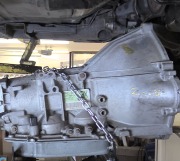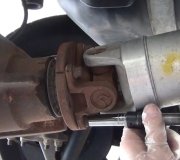P0720 - Output Speed Sensor Circuit Malfunction
P0732 - Gear 2 Incorrect ratio
Yup. Diagnostic fault codes never say to replace parts, as you can see in these descriptions. They only indicate the circuit or system that needs further diagnosis, or the unacceptable operating condition.
BMW is one of the worst manufacturers for customer-friendly business practices, and one of them is that they're very stingy with service information, so all I can go on is these generic code descriptions. For an explanation of what MIGHT be happening, I have to defer to my Chrysler experience. They were the first to use a computer-controlled transmission and I can share what to look for if yours uses the same system.
First of all, there's only a 50 percent chance a sensor referenced in a fault code is the cause of that code. You also have to look for wiring and connector pin problems. Part of that diagnosis requires a scanner, and you may be out of luck unless you go right to a BMW dealer. Most manufacturers work with the aftermarket industry to make their information available so they can develop and program their scanners, but sometimes the aftermarket suppliers have to reverse-engineer the car and do what little they can. Most of us are very limited on what we can do on BMWs.
There's two things to consider with code 732. The first is that code will set when there's slippage in one of the clutch packs. Again, I'm working from Chrysler experience. The clutch plates are wearing a little with every shift cycle, and years ago those shifts gradually got sloppy or mushy, and you had a year or two of warning that a transmission rebuild was in your future. With this design, the computer knows the volume of fluid it takes to apply each clutch pack. As the plates wear, that volume goes up. In response, the computer will update the shift timing to maintain that nice crisp shift. In this case it will engage third gear a little sooner, and delay the disengagement of second gear a little to insure third gear is locked up. Eventually the day comes when it can't update any further and that slippage occurs, usually during an up-shift. That slippage is detected by the computer seeing the speeds reported by the input speed sensor, (crankshaft speed), and output speed sensor, (drive shaft speed). It knows, based on the gear it has selected, what the output speed should be for any given input speed.
When this type of code is set, the computer defaults to "limp" mode which is second gear. That is to allow you to drive slowly to a repair shop without needing a tow truck. You have to turn the ignition switch off, then restart the engine to get it out of limp mode.
That said, you also have to consider the first code. That won't set in relation to clutch pack slippage, but a sensor circuit problem can give the computer inaccurate speed information which can send it into limp mode. Therefore, the incorrect gear ratio may be the result of bad sensor data and not slippage in the transmission. Typically the slippage problem occurs at high mileages or when a car with an automatic transmission has been stored a long time and the clutch plates dry out. That causes them to crumble and turn to powder.
Start by inspecting the wires for that sensor, then check the connector terminals for corrosion or if they're spread and making intermittent contact. Next, you'll need a scanner to view live data and see the speeds being reported by both sensors.
Friday, July 18th, 2014 AT 7:50 PM


